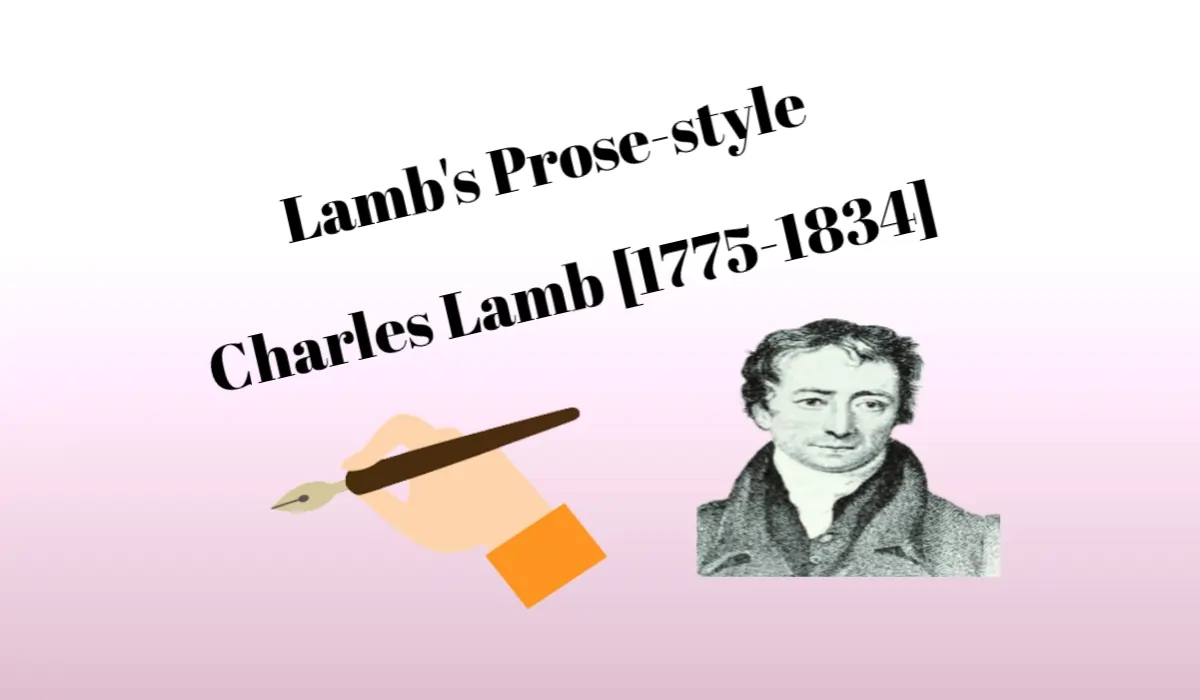Lamb’s Prose-style
Contents
Introduction
The most important characteristic of the style of Charles Lamb in his essays is that it is pre-eminently subjective, confidential and communicative. Lamb’s essays are the essays of the purely literary type as opposed to the other type such as those of Johnson or Macaulay. Lamb’s essays are nothing but only essays–incomplete but rounded treatment of a subject matter from one point of view. Each of the essays is delicious, outpouring of the passing mood of the writer with no other intent than realizing such an idea and emotion to the reader’s ears. Each of the essays moves round a central topic, and is moulded like a lyric by the emotion of the moment.
Lamb Himself The Central Subject Matter
The central subject matter of his essays is Lamb himself. He assures the friendship of his reader, takes him into his confidence, jokes with him, and mystifies him, exactly in the same way as he treated his actual friends. Like Montaigne Lamb always speaks of himself in the first person because he is the first person who is the most intimately known to himself. Taken together his essays help us to reconstruct the whole life of Lamb in all its phases and interests. In other words, each of the essays is a bit of autobiography-but much more than this, each is a fragment of the spiritual history of his inner life.
Plain Style of Lamb
Lamb is mostly in the mood of friendship and the general style of his essays is one based on plain 18th century style of Addison in ‘The Spectator’. But in richness of fancy and liveliness his style is much superior resembling and rather than the style of Izaak Walton. The plain style in Lamb’s hand is given a somewhat startling turn by the introduction of antique words, or phrases here and there.
“Odd, out of the way old English plays and treatises had supplied me with most of my motions and ways of feelings,” Lamb writes about his study. This sentence is a key not only to shape his mind but also to shape his style.
There was an antique term in Lamb’s soul which drew him to the Elizabethans and the great romanticists of the 17th century prose-literature–Browne, Donne, Burton, Jeremy Taylor, Fuller and Izaak Walton. He imitates their style in various places in his essays. Hazlitt says, “Lamb is so imbued with the spirits of the authors that the idea of imitation is almost done away.” When he was in a fanciful and reflective vein he wrote like Sir Thomas Browne. When writing fantastically he would be like Donne or Burton. When indulging in pure wit and fun he could write like Fuller. When purely descriptive he wrote like Walton. When grave and didactic he wrote like Bacon.
Characteristics of Lamb’s Style
In the preface to his ‘Last Essays of Elia’ Lamb jokingly admits that his essays “are crude-a sort of un-liked, in-condite things, villainously pranked in an affected array of antique modes and phrases.” This admission is a nice key to one of the main characteristics of Lamb’s style.
The following characteristics of Lamb’s style should be noted :
(I) The essays are “crude-a sort of un-liked, in-condite things.” In other words they are haphazard and unmethodical. But there is a silver thread of unity. His sentences are sometimes ungrammatical, but because of force, clearness, romantic suggestiveness his sentences are unimpeachable.
Sometimes his essays open with a description which seems to have little connection with the subject in hand. But the opening, the middle, and the end are seen ultimately to merge into one single topic. Lamb’s essays are nothing if not delightful. No one goes to him for instruction or spiritual exhortation. He essays offer pure delight to the readers. According to Swinburne, we find a homely magic in the name of Lamb.
(II) Lamb’s essays are ‘villainously pranked’ and they are full of ‘antique modes and phrases’. There is no doubt that Lamb’s style has an antique flavour. It is rich in allusiveness. It teems with quotations-sometimes direct from his studies, sometimes turned and twisted to suit his purpose. He quotes from his past masters–“Apparition of a child, crowned with a tree in his hand rises” [From Shakespeare’s “Macbeth“–In “The Praise of Chimney Sweepers”] He also quotes from his contemporaries–“I saw skirts of the departing year.” [Coleridge–In “New Year’s Eve”]
“Lie down with Kings,”–a reminiscence of a passage in Browne’s. “Welcome the coming, speed the parting guest.” [From Pope’s translation of Homer’s Odyssey] Single word quotation ‘tide’ [Wordsworth’s ‘The Prelude‘—The great tide of human life.] Transformed quotations–“dropped like mellow fruit”–Dryden’s ‘Oedipus‘ —Fell like Autumn fruit that mellowed long.
(III) The most noticeable and certainly the most enjoyable quality that marks the style of Lamb is his humour. His humour found its best expression in the quaint words and antique phrases and sometimes far-fetched comparisons. If we strip Elia of these, he is nothing. Indeed his humour expresses itself in various forms and it is often allied to pathos. His smile is a cover to hide the tears that he would rain i.e. shed tears to relieve himself.
Lamb’s style cannot be separated from his humour. In the essay,“The Praise of Chimney Sweepers”, he uses a pun–“May the Brush supersede the Laurel!” Here we find a play on the sense of word “Brush”–(a) the painter’s brush; and (b) the chimney sweeper’s brush.
(IV) Lamb’s finest essays are poetic because they have the creative imagination which is a distinguishing mark of poetry. We may note this quality in “Dream Children : A Reverie”. This is a lyrical utterance which is a sympathy, and which rises in a single swell and ends in a dying fall. Really it is a lyric in prose.
Conclusion
When all is said and done, it is style that gives immortality to Lamb’s essays. In the words of Lamb the essay is bound up not only with his life but also with his style which is only expressed in his life itself. Really here we may say, “Style is the man.
——————-
Questions of Universities
[I] In what point of Lamb is archaic, allusive and didactic? Discuss with reference to the prescribed essays.
[II] Analyze Lamb’s prose-style with reference to his essays that are on your syllabus.
———————



